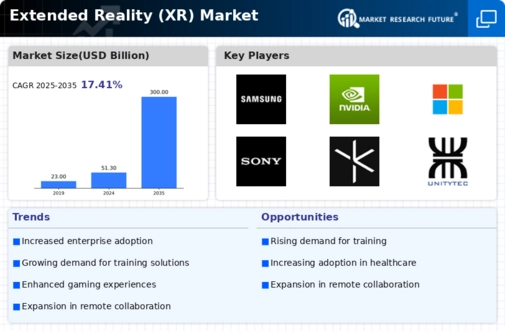Market Growth Projections
The Global Extended Reality (XR) Market Industry is projected to experience substantial growth, with estimates indicating a market value of 51.3 USD Billion in 2024 and a remarkable increase to 300 USD Billion by 2035. This growth trajectory reflects a compound annual growth rate of 17.41% from 2025 to 2035, driven by advancements in technology, increased adoption across various sectors, and rising consumer demand. As industries continue to explore the potential of XR, the market is poised for transformative developments that could redefine user experiences and applications across multiple domains.
Technological Advancements
The Global Extended Reality (XR) Market Industry is propelled by rapid technological advancements in hardware and software. Innovations in graphics processing units, display technologies, and motion tracking systems enhance user experiences, making XR applications more immersive and accessible. For instance, the introduction of lightweight headsets with improved resolution and field of view has broadened the appeal of XR across various sectors, including gaming, education, and healthcare. As these technologies evolve, they are expected to contribute significantly to the market's growth, with projections indicating a market value of 51.3 USD Billion in 2024.
Increased Adoption in Education
The Global Extended Reality (XR) Market Industry is witnessing increased adoption in the education sector, where immersive learning experiences are becoming more prevalent. XR technologies facilitate interactive simulations and virtual classrooms, enhancing student engagement and comprehension. For example, institutions are utilizing XR for training medical students in surgical procedures or providing virtual field trips to historical sites. This trend is likely to expand as educational institutions recognize the benefits of XR, potentially contributing to the market's growth trajectory, which is projected to reach 300 USD Billion by 2035.
Rising Consumer Interest in Gaming
The Global Extended Reality (XR) Market Industry is significantly influenced by the rising consumer interest in gaming experiences that leverage XR technologies. Gamers are increasingly seeking immersive environments that enhance gameplay, leading to a surge in demand for XR-enabled games and platforms. Companies are investing heavily in developing XR content that captivates audiences, with the gaming sector projected to be a primary driver of market growth. As the gaming industry continues to innovate and expand, it is likely to contribute to the overall market value, reinforcing the importance of XR in entertainment.
Expansion in Healthcare Applications
The Global Extended Reality (XR) Market Industry is expanding rapidly within the healthcare sector, where XR technologies are utilized for training, therapy, and patient education. Medical professionals are employing XR for surgical simulations and patient rehabilitation, providing immersive experiences that improve outcomes. For instance, XR applications are being used to treat phobias and anxiety disorders through exposure therapy. As healthcare providers recognize the potential of XR to enhance patient care and training, the market is poised for substantial growth, aligning with the broader trend of increasing investment in healthcare technology.
Growing Demand for Remote Collaboration
The Global Extended Reality (XR) Market Industry is experiencing a surge in demand for remote collaboration tools, particularly in the wake of evolving work environments. XR technologies enable virtual meetings and collaborative workspaces that transcend geographical barriers, fostering productivity and innovation. Companies are increasingly adopting XR solutions for training, design reviews, and project management, which enhances team collaboration. This trend is expected to drive market growth, with a compound annual growth rate of 17.41% anticipated from 2025 to 2035, reflecting the increasing reliance on XR for effective communication and teamwork.























